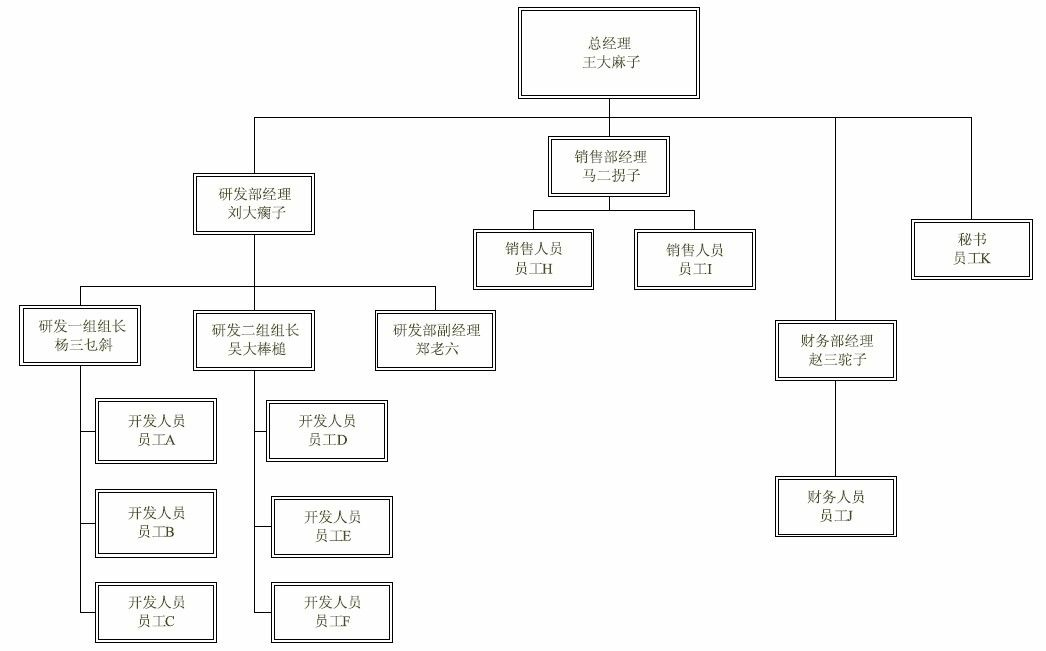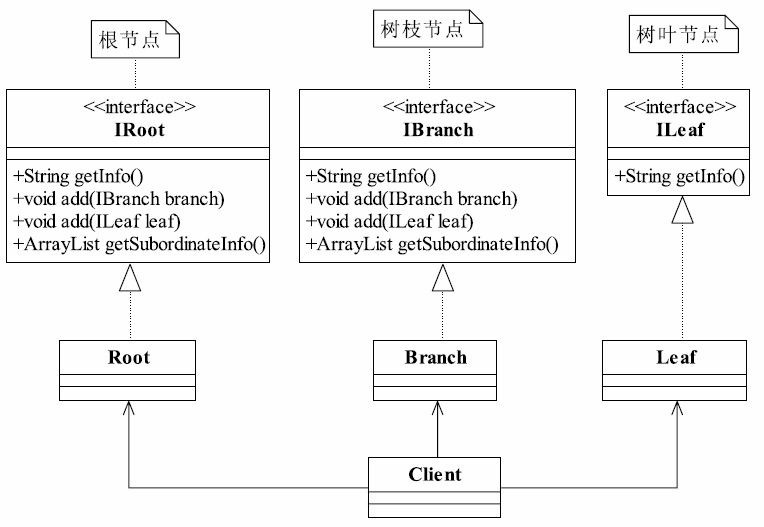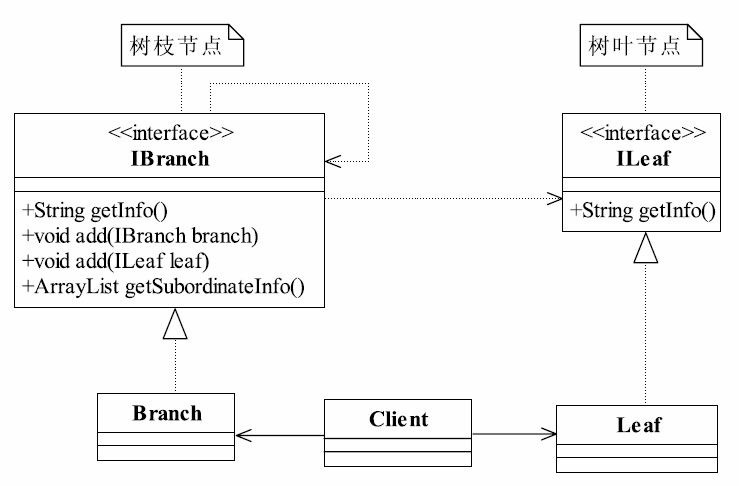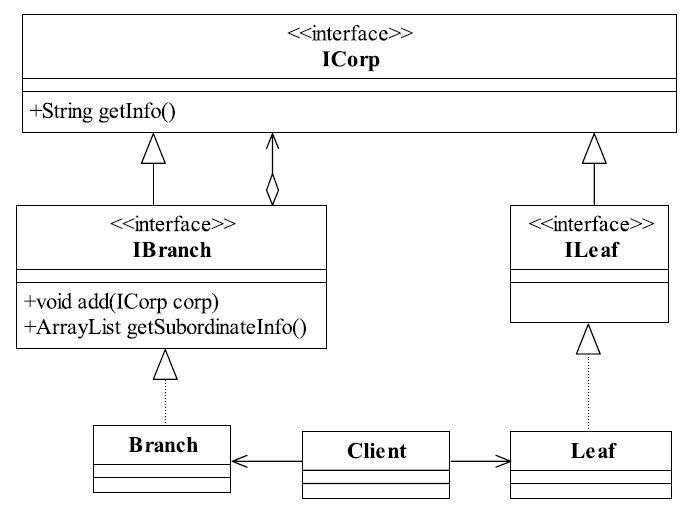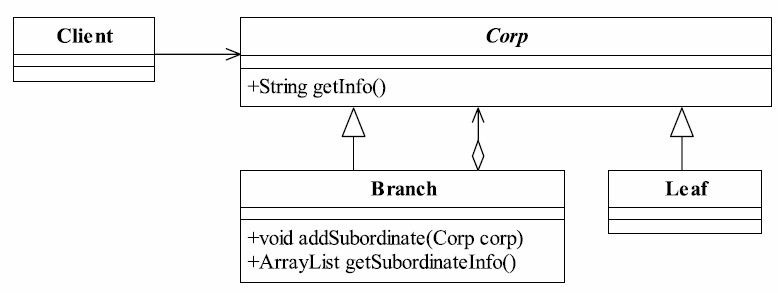21.1 公司的人事架构是这样的吗
各位读者,大家在上学的时候应该都学过“数据结构”这门课程吧,还记得其中有一节叫“二叉树”吧,我们上学那会儿这一章节是必考内容,左子树,右子树,什么先序遍历、后序遍历,重点就是二叉树的遍历,我还记得当时老师就说,考试的时候一定有二叉树的构建和遍历,现在想起来还是觉得老师是正确的,树状结构在实际中应用非常广泛,想想看你最常使用的XML格式是不是就是一个树形结构。
咱就先说个最常见的例子,公司的人事管理就是一个典型的树状结构,想想看你公司的组织架构是不是如图21-1所示。
![image-20210929170413274]()
图21-1 普遍的组织架构
从最高的老大,往下一层一层的管理,最后到我们这层小兵……很典型的树状结构(说明一下,这不是二叉树,有关二叉树的定义可以翻翻以前的教科书),我们今天的任务就是要把这个树状结构实现出来,并且还要把它遍历一遍,就类似于阅读你公司的人员花名册。
从该树状结构上分析,有两种不同性质的节点:有分支的节点(如研发部经理)和无分支的节点(如员工A、员工D等),我们增加一点学术术语上去,总经理叫做根节点(是不是想到XML中的那个根节点root,那就对了),类似研发部经理有分支的节点叫做树枝节点,类似员工A的无分支的节点叫做树叶节点,都很形象,三个类型的节点,那是不是定义三个类就可以?好,我们按照这个思路走下去,先看我们自己设计的类图,如图21-2所示。
![image-20210929170508685]()
图21-2 最容易想到的组织架构类图
这个类图是初学者最容易想到的类图(首先声明,这个类图是有缺陷的,如果你已经看明白这个类图的缺陷了,该段落就可以一目十行地看下去,我们是循序渐进地讲课,一步一个脚印),非常简单,我们来看一下如何实现,先看最高级别的根节点接口,如代码清单21-1所示。
代码清单21-1 根节点接口
1
2
3
4
5
6
7
8
9
10
| public interface IRoot {
public String getInfo();
public void add(IBranch branch);
public void add(ILeaf leaf);
public ArrayList getSubordinateInfo();
}
|
这个根节点的对象就是我们的总经理,其具体实现如代码清单21-2所示。
代码清单21-2 根节点的实现
1
2
3
4
5
6
7
8
9
10
11
12
13
14
15
16
17
18
19
20
21
22
23
24
25
26
27
28
29
30
31
32
33
34
35
36
37
38
| public class Root implements IRoot {
private ArrayList subordinateList = new ArrayList();
private String name = "";
private String position = "";
private int salary = 0;
public Root(String name,String position,int salary){
this.name = name;
this.position = position;
this.salary = salary;
}
public void add(IBranch branch) {
this.subordinateList.add(branch);
}
public void add(ILeaf leaf) {
this.subordinateList.add(leaf);
}
public String getInfo() {
String info = "";
info = "名称:"+ this.name;
;
info = info + "\t职位:" + this.position;
info = info + "\t薪水: " + this.salary;
return info;
}
public ArrayList getSubordinateInfo() {
return this.subordinateList;
}
}
|
很简单,通过构造函数传入参数,然后获得信息,可以增加子树枝节点(部门经理)和叶子节点(秘书)。我们再来看其他有分支的节点接口,如代码清单21-3所示。
代码清单21-3 其他有分支的节点接口
1
2
3
4
5
6
7
8
9
10
| public interface IBranch {
public String getInfo();
public void add(IBranch branch);
public void add(ILeaf leaf);
public ArrayList getSubordinateInfo();
}
|
有了接口,就应该有实现,其具体的实现类,如代码清单21-4所示。
代码清单21-4 分支的节点实现
1
2
3
4
5
6
7
8
9
10
11
12
13
14
15
16
17
18
19
20
21
22
23
24
25
26
27
28
29
30
31
32
33
34
35
36
37
| public class Branch implements IBranch {
private ArrayList subordinateList = new ArrayList();
private String name="";
private String position = "";
private int salary = 0;
public Branch(String name,String position,int salary){
this.name = name;
this.position = position;
this.salary = salary;
}
public void add(IBranch branch) {
this.subordinateList.add(branch);
}
public void add(ILeaf leaf) {
this.subordinateList.add(leaf);
}
public String getInfo() {
String info = "";
info = "名称:" + this.name;
info = info + "\t职位:"+ this.position;
info = info + "\t薪水:"+this.salary;
return info;
}
public ArrayList getSubordinateInfo() {
return this.subordinateList;
}
}
|
不管是总经理还是部门经理都是有子节点的存在,最终的子节点就是叶子节点,其接口如代码清单21-5所示。
代码清单21-5 叶子节点的接口
1
2
3
4
| public interface ILeaf {
public String getInfo();
}
|
叶子节点的接口简单,实现也非常容易,如代码清单21-6所示。
代码清单21-6 叶子节点的实现
1
2
3
4
5
6
7
8
9
10
11
12
13
14
15
16
17
18
19
20
21
22
| public class Leaf implements ILeaf {
private String name = "";
private String position = "";
private int salary=0;
public Leaf(String name,String position,int salary){
this.name = name;
this.position = position;
this.salary = salary;
}
public String getInfo() {
String info = "";
info = "名称:" + this.name;
info = info + "\t职位:"+ this.position;
info = info + "\t薪水:"+this.salary;
return info;
}
}
|
好了,所有的根节点、树枝节点和叶子节点都已经实现了,从总经理、部门经理到最终的员工都已经实现,然后的工作就是组装成一个树状结构并遍历这棵树,通过什么来完成呢?通过场景类Client完成,如代码清单21-7所示。
代码清单21-7 场景类
1
2
3
4
5
6
7
8
9
10
11
12
13
14
15
16
17
18
19
20
21
22
23
24
25
26
27
28
29
30
31
32
33
34
35
36
37
38
39
40
41
42
43
44
45
46
47
48
49
50
51
52
53
54
55
56
57
58
59
60
61
62
63
64
65
66
67
68
69
70
71
72
73
| public class Client {
public static void main(String[] args) {
IRoot ceo = new Root("王大麻子","总经理",100000);
IBranch developDep = new Branch("刘大瘸子","研发部门经理",10000);
IBranch salesDep = new Branch("马二拐子","销售部门经理",20000);
IBranch financeDep = new Branch("赵三驼子","财务部经理",30000);
IBranch firstDevGroup = new Branch("杨三乜斜","开发一组组长",5000);
IBranch secondDevGroup = new Branch("吴大棒槌","开发二组组长",6000);
ILeaf a = new Leaf("a","开发人员",2000);
ILeaf b = new Leaf("b","开发人员",2000);
ILeaf c = new Leaf("c","开发人员",2000);
ILeaf d = new Leaf("d","开发人员",2000);
ILeaf e = new Leaf("e","开发人员",2000);
ILeaf f = new Leaf("f","开发人员",2000);
ILeaf g = new Leaf("g","开发人员",2000);
ILeaf h = new Leaf("h","销售人员",5000);
ILeaf i = new Leaf("i","销售人员",4000);
ILeaf j = new Leaf("j","财务人员",5000);
ILeaf k = new Leaf("k","CEO秘书",8000);
ILeaf zhengLaoLiu = new Leaf("郑老六","研发部副总",20000);
ceo.add(developDep);
ceo.add(salesDep);
ceo.add(financeDep);
ceo.add(k);
developDep.add(firstDevGroup);
developDep.add(secondDevGroup);
developDep.add(zhengLaoLiu);
firstDevGroup.add(a);
firstDevGroup.add(b);
firstDevGroup.add(c);
secondDevGroup.add(d);
secondDevGroup.add(e);
secondDevGroup.add(f);
salesDep.add(h);
salesDep.add(i);
financeDep.add(j);
System.out.println(ceo.getInfo());
getAllSubordinateInfo(ceo.getSubordinateInfo());
}
private static void getAllSubordinateInfo(ArrayList subordinateList){
int length = subordinateList.size();
for(int m=0;m<length;m++){
Object s = subordinateList.get(m);
if(s instanceof Leaf){
ILeaf employee = (ILeaf)s;
System.out.println(((Leaf) s).getInfo());
}
else{
IBranch branch = (IBranch)s;
System.out.println(branch.getInfo());
getAllSubordinateInfo(branch.getSubordinateInfo());
}
}
}
}
|
这个程序比较长,如果在我们的项目中有这样的程序,肯定是要被拉出来做典型的,你写一大坨的程序给谁呀,以后还要维护,程序要短小精悍!幸运的是,我们这是作为案例来讲解,而且就是指出这样组装这棵树是有问题的,等会我们深入讲解,先看运行结果:
1
2
3
4
5
6
7
8
9
10
11
12
13
14
15
16
17
| 名称:王大麻子 职位:总经理 薪水: 100000
名称:刘大瘸子 职位:研发部门经理 薪水:10000
名称:杨三乜斜 职位:开发一组组长 薪水:5000
名称:a 职位:开发人员 薪水:2000
名称:b 职位:开发人员 薪水:2000
名称:c 职位:开发人员 薪水:2000
名称:吴大棒槌 职位:开发二组组长 薪水:6000
名称:d 职位:开发人员 薪水:2000
名称:e 职位:开发人员 薪水:2000
名称:f 职位:开发人员 薪水:2000
名称:郑老六 职位:研发部副总 薪水:20000
名称:马二拐子 职位:销售部门经理 薪水:20000
名称:h 职位:销售人员 薪水:5000
名称:i 职位:销售人员 薪水:4000
名称:赵三驼子 职位:财务部经理 薪水:30000
名称:j 职位:财务人员 薪水:5000
名称:k 职位:CEO秘书 薪水:8000
|
和我们期望的结果一样,一棵完整的树就生成了,而且我们还能够遍历。不错,不错, 但是看类图或程序的时候,你有没有发觉有问题?getInfo每个接口都有,为什么不能抽象出来?Root类和Branch类有什么差别?根节点本身就是树枝节点的一种,为什么要定义成两个接口两个类?如果我要加一个任职期限,你是不是每个类都需要修改?如果我要后序遍历 (从员工找到他的上级领导)能做到吗?——彻底晕菜了!
问题很多,我们一个一个解决,先说抽象的问题。我们确实可以把IBranch和IRoot合并成一个接口,确认无疑的事我们先做,那我们就修改一下类图,如图21-3所示。
仔细看看这个类图,还能不能发现点问题。想想看接口的作用是什么?定义一类事物所具有的共性,那ILeaf和IBranch是不是也有共性呢?有,getInfo方法!我们是不是要把这个共性也封装起来呢?是的,是的,提炼事物的共同点,然后封装之,这是我们作为设计专家的拿手好戏,修改后的类图如图21-4所示。
![image-20210929171106675]()
图21-3 整合根节点和树枝节点后的类图
![image-20210929171143357]()
图21-4 修改后的类图
类图上增加了一个ICorp接口,它是公司所有人员信息的接口类,不管你是经理还是员工,你都有名字、职位、薪水,这个定义成一个接口没有错,但是你可能对于ILeaf接口持怀疑状态,空接口有何意义呀?有意义!它是每个树枝节点的代表,系统扩容的时候你就会发现它是多么“栋梁”。我们先来看新增加的接口ICorp,如代码清单21-8所示。
代码清单21-8 公司人员接口
1
2
3
4
| public interface ICorp {
public String getInfo();
}
|
接口很简单,只有一个方法,就是获得员工的信息,树叶节点是最基层的构件,我们先来看看它的接口,空接口,如代码清单21-9所示。
代码清单21-9 树叶接口
1
2
| public interface ILeaf extends ICorp {
}
|
树叶接口的实现类,如代码清单21-10所示。
代码清单21-10 树叶接口
1
2
3
4
5
6
7
8
9
10
11
12
13
14
15
16
17
18
19
20
21
22
| public class Leaf implements ILeaf {
private String name = "";
private String position = "";
private int salary = 0;
public Leaf(String name,String position,int salary){
this.name = name;
this.position = position;
this.salary = salary;
}
public String getInfo() {
String info = "";
info = "姓名:" + this.name;
info = info + "\t职位:"+ this.position;
info = info + "\t薪水:" + this.salary;
return info;
}
}
|
小兵就只有这些信息了,我们是具体干活的,我们是管理不了其他同事的,我们来看看那些经理和小组长是怎么实现的,也就是IBranch接口,如代码清单21-11所示。
代码清单21-11 树枝接口
1
2
3
4
5
6
7
8
| public interface IBranch extends ICorp {
public void addSubordinate(ICorp corp);
public ArrayList<ICorp> getSubordinate();
}
|
接口也很简单,其实现类也不可能太复杂,如代码清单21-12所示。
代码清单21-12 树枝实现类
1
2
3
4
5
6
7
8
9
10
11
12
13
14
15
16
17
18
19
20
21
22
23
24
25
26
27
28
29
30
31
32
| public class Branch implements IBranch {
private String name = "";
private String position = "";
private int salary = 0;
ArrayList<ICorp> subordinateList = new ArrayList<ICorp>();
public Branch(String name,String position,int salary){
this.name = name;
this.position = position;
this.salary = salary;
}
public void addSubordinate(ICorp corp) {
this.subordinateList.add(corp);
}
public ArrayList<ICorp> getSubordinate() {
return this.subordinateList;
}
public String getInfo() {
String info = "";
info = "姓名:" + this.name;
info = info + "\t职位:"+ this.position;
info = info + "\t薪水:" + this.salary;
return info;
}
}
|
实现类也很简单,不多说,程序写得好不好,就看别人怎么调用了,我们看场景类Client,如代码清单21-13所示。
代码清单21-13 场景类a
1
2
3
4
5
6
7
8
9
10
11
12
13
14
15
16
17
18
19
20
21
22
23
24
25
26
27
28
29
30
31
32
33
34
35
36
37
38
39
40
41
42
43
44
45
46
47
48
49
50
51
52
53
54
55
56
57
58
59
60
61
62
63
64
65
66
67
68
69
70
71
72
73
74
75
| public class Client {
public static void main(String[] args) {
Branch ceo = compositeCorpTree();
System.out.println(ceo.getInfo());
System.out.println(getTreeInfo(ceo));
}
public static Branch compositeCorpTree(){
Branch root = new Branch("王大麻子","总经理",100000);
Branch developDep = new Branch("刘大瘸子","研发部门经理",10000);
Branch salesDep = new Branch("马二拐子","销售部门经理",20000);
Branch financeDep = new Branch("赵三驼子","财务部经理",30000);
Branch firstDevGroup = new Branch("杨三乜斜","开发一组组长",5000);
Branch secondDevGroup = new Branch("吴大棒槌","开发二组组长",6000);
Leaf a = new Leaf("a","开发人员",2000);
Leaf b = new Leaf("b","开发人员",2000);
Leaf c = new Leaf("c","开发人员",2000);
Leaf d = new Leaf("d","开发人员",2000);
Leaf e = new Leaf("e","开发人员",2000);
Leaf f = new Leaf("f","开发人员",2000);
Leaf g = new Leaf("g","开发人员",2000);
Leaf h = new Leaf("h","销售人员",5000);
Leaf i = new Leaf("i","销售人员",4000);
Leaf j = new Leaf("j","财务人员",5000);
Leaf k = new Leaf("k","CEO秘书",8000);
Leaf zhengLaoLiu = new Leaf("郑老六","研发部副经理",20000);
root.addSubordinate(k);
root.addSubordinate(developDep);
root.addSubordinate(salesDep);
root.addSubordinate(financeDep);
developDep.addSubordinate(zhengLaoLiu);
developDep.addSubordinate(firstDevGroup);
developDep.addSubordinate(secondDevGroup);
firstDevGroup.addSubordinate(a);
firstDevGroup.addSubordinate(b);
firstDevGroup.addSubordinate(c);
secondDevGroup.addSubordinate(d);
secondDevGroup.addSubordinate(e);
secondDevGroup.addSubordinate(f);
salesDep.addSubordinate(h);
salesDep.addSubordinate(i);
financeDep.addSubordinate(j);
return root;
}
public static String getTreeInfo(Branch root){
ArrayList<ICorp> subordinateList = root.getSubordinate();
String info = "";
for(ICorp s :subordinateList){
if(s instanceof Leaf){
info = info + s.getInfo()+"\n";
}
else{
info = info + s.getInfo() +"\n"+ getTreeInfo((Branch)s);
}
}
return info;
}
}
|
运行结果完全相同,不再赘述。通过这样构件,一个非常清晰的树状人员资源管理图出现了,那我们的程序是否还可以优化?可以!你看Leaf和Branch中都有getInfo信息,是不是可以抽象?好,我们抽象一下,如图21-5所示。
![image-20210929171702993]()
图21-5 精简的类图
你一看这个图,乐了。能不乐嘛,减少很多工作量了,接口没有了,改成抽象类了,IBranch接口也没有了,直接把方法放到了实现类中了,太精简了!而且场景类只认定抽象类Corp就成,那我们首先来看抽象类ICorp,如代码清单21-14所示。
代码清单21-14 抽象公司职员类
1
2
3
4
5
6
7
8
9
10
11
12
13
14
15
16
17
18
19
20
21
22
| public abstract class Corp {
private String name = "";
private String position = "";
private int salary =0;
public Corp(String _name,String _position,int _salary){
this.name = _name;
this.position = _position;
this.salary = _salary;
}
public String getInfo(){
String info = "";
info = "姓名:" + this.name;
info = info + "\t职位:"+ this.position;
info = info + "\t薪水:" + this.salary;
return info;
}
}
|
抽象类嘛,就应该抽象出一些共性的东西出来,然后看两个具体的实现类,树叶节点如代码清单21-15所示。
代码清单21-15 树叶节点
1
2
3
4
5
6
| public class Leaf extends Corp {
public Leaf(String _name,String _position,int _salary){
super(_name,_position,_salary);
}
}
|
这个精简得比较多,几行代码就完成了,确实就应该这样,下面是小头目的实现类,如代码清单21-16所示。
代码清单21-16 树枝节点
1
2
3
4
5
6
7
8
9
10
11
12
13
14
15
16
| public class Branch extends Corp {
ArrayList<Corp> subordinateList = new ArrayList<Corp>();
public Branch(String _name,String _position,int _salary){
super(_name,_position,_salary);
}
public void addSubordinate(Corp corp) {
this.subordinateList.add(corp);
}
public ArrayList<Corp> getSubordinate() {
return this.subordinateList;
}
}
|
场景类中构建树形结构,并进行遍历。组装没有变化,遍历组织机构数稍有变化,如代码清单21-17所示。
代码清单21-17 稍稍修改的场景类
1
2
3
4
5
6
7
8
9
10
11
12
13
14
15
16
17
18
| public class Client {
public static String getTreeInfo(Branch root){
ArrayList<Corp> subordinateList = root.getSubordinate();
String info = "";
for(Corp s :subordinateList){
if(s instanceof Leaf){
info = info + s.getInfo()+"\n";
}
else{
info = info+s.getInfo()+"\n"+ getTreeInfo((Branch)s);
}
}
return info;
}
}
|
场景类中main方法没有变动,请参考代码清单21-7所示,不再赘述。遍历组织机构树的getTreeInfo稍有修改,就是把用到ICorp接口的地方修改为Corp抽象类,仅仅修改了粗体部分,其他保持不变,运行结果相同。这就是组合模式。
